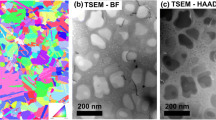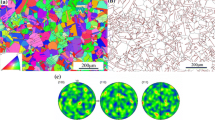Abstract
Crack growth experiments have been carried out under combined creep and fatigue loading at 700° C on a hot isostatically pressed powder nickel alloy. A fractographic investigation has been undertaken of the modes of failure over a frequency range of 0.001 to 10 Hz. The observations indicate that under static loading and at low frequencies failure is intergranular and controlled by creep processes, whereas at high frequencies a transgranular fatigue fracture is obtained. The transition from creep to fatigue behaviour is found to be progressive, and to begin at a lower frequency the higher the ratio of cyclic to mean load. In the transition region a mixed intergranular and transgranular fracture surface is observed, which correlates well with the recorded proportion of creep to fatigue crack growth.
Similar content being viewed by others
References
R. M. Pelloux andJ. S. Huang, Proceedings of Conference on Creep-Fatigue-Enviroment Interactions, edited by R. Pelloux and M. Stoloff, Wisconsin (TMS-AIME, Warrendale, 1979) p. 151.
K. Sadananda andP. Shahinian, “Cavities and Cracks in Creep and Fatigue”, edited by J. H. Gittus (Applied Science, London, 1981) p. 109.
D. J. Smith andG. A. Webster, “Mechanical Behaviour of Materials — IV”, Vol. 1, edited by J. Carlson and N. G. Ohlson (Pergamon, London, 1983) p. 315.
A. Pineau, “Fatigue at High Temperature”, edited by R. P. Skelton (Applied Science, London, 1983) p. 305.
K. M. Nikbin andG. A. Webster, “Creep and Fracture of Engineering Materials and Structures”, Part II, edited by B. Wilshire and D. R. J. Owen (Pineridge Press, Swansea, 1984) p. 1091.
P. Paris andF. Erdogan,J. Basic Eng., Trans. ASME 85 (1963) 528.
M. P. Harper andE. G. Ellison,J. Strain Analysis 12 (1977) 167.
K. M. Nikbin, D. J. Smith, andG. A. Webster, Proceedings of Conference on Advances in Life Prediction Methods at Elevated Temperatures, Albany, April 1983 edited by D. A. Woodford and J. R. Whitehead (ASME, New York, 1983) p. 249.
G. A. Webster, “Engineering Approaches to High Temperature Design”, edited by B. Wilshire and D. R. J. Owen (Pineridge Press, Swansea, 1983) p. 1.
ASTM E647-78T, “Tentative Test Methods for Constant Load Amplitude Fatigue Crack Growth Rates above 10−8 m/cycle” (American Society for Testing and Materials, Philadelphia 1978) p. 662.
Author information
Authors and Affiliations
Rights and permissions
About this article
Cite this article
Winstone, M.R., Nikbin, K.M. & Webster, G.A. Modes of failure under creep/fatigue loading of a nickel-based superalloy. J Mater Sci 20, 2471–2476 (1985). https://doi.org/10.1007/BF00556076
Received:
Accepted:
Issue Date:
DOI: https://doi.org/10.1007/BF00556076




